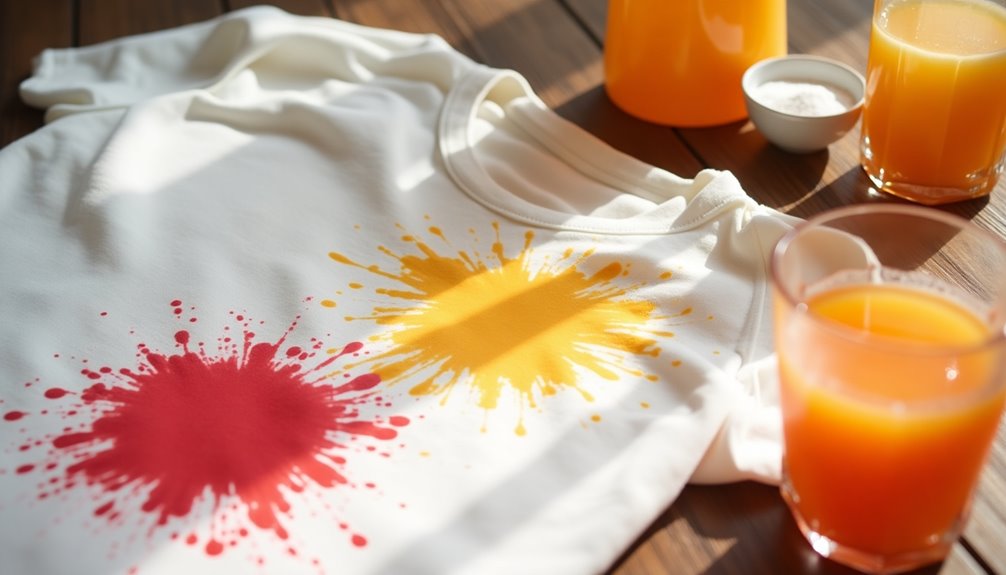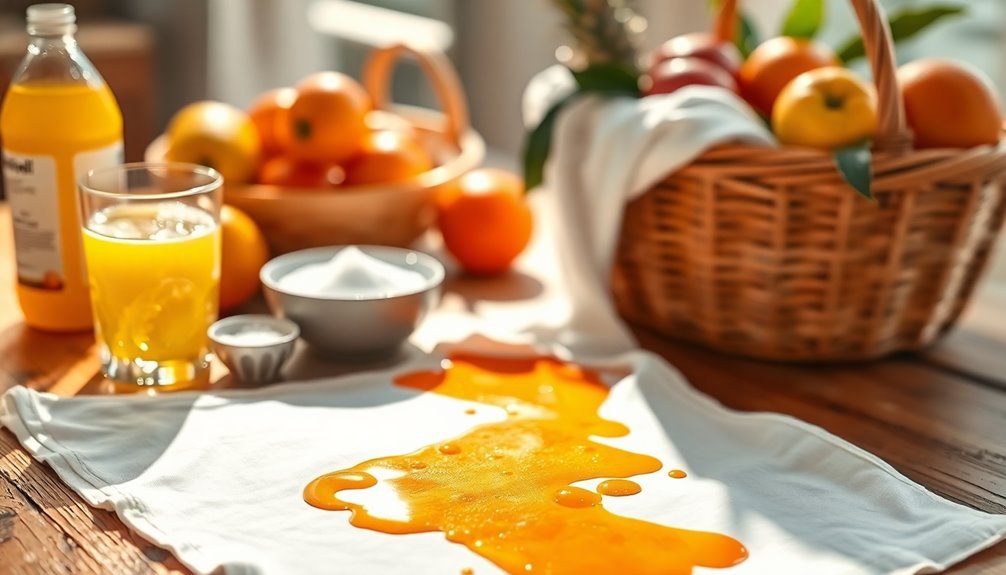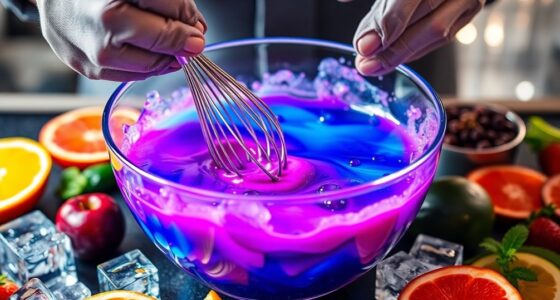If you've spilled fruit juice on your clothes, act fast! Rinse the fabric under cold water to dilute the juice. Then, apply liquid laundry detergent like Tide directly onto the stain and let it sit for five minutes. For dried stains, use glycerin to loosen it before washing. Wash on the hottest setting allowed by the care label, but don't dry your garment until the stain is completely gone. Stick around to discover more tips for stubborn stains!
Key Takeaways
- Rinse the fabric under cold water immediately to dilute the fruit juice and prevent the stain from setting.
- Apply liquid laundry detergent, like Tide HE Turbo Clean, directly onto the stain and let it sit for five minutes.
- For dried stains, use glycerin to loosen the stain before washing; rub it gently into the fabric.
- Wash the garment on the hottest setting allowed by the care label to break down remaining stain traces.
- Avoid drying the garment until the stain is completely removed, as heat can set the stain permanently.

When you spill fruit juice on your clothes, it can feel like a disaster, but don't worry—acting quickly can save your garment. The key to successfully removing fruit stains from clothes lies in the speed of your response. As soon as you notice the stain, head to the sink or grab some cold water. Rinse the fabric under cold water to dilute the juice. This initial flush helps to prevent the stain from setting in, making it easier to remove later.
Once you've rinsed the stain, it's time to pre-treat the stain. For this, grab your liquid laundry detergent—Tide HE Turbo Clean Liquid is an excellent choice. Pour it directly onto the stain, ensuring you cover it completely. Let it sit for about five minutes. This pre-treatment step is crucial because it allows the cleaning solution to penetrate the fibers and break down the stain before you toss it in the washing machine.
If you're dealing with a stubborn stain, particularly if the fruit juice has dried, you might need to use a little extra help. Glycerin is a great addition at this stage. Apply some glycerin directly to the dried stain and gently rub it in. This process loosens the stain, making it easier to wash away in the next step. Once you've given the glycerin a few minutes to work its magic, you can proceed to wash the garment.
When it's time to load your clothing into the washing machine, make sure you select the hottest setting recommended by the care label. Hotter water helps to break down any remaining traces of the stain and ensures optimal cleaning power. However, be cautious—never dry the garment until you're certain the stain is completely gone. If you dry it while the stain is still there, it could set permanently, leaving you with a frustrating reminder of your juice mishap.
For those moments when you're out and about, or if you need to act fast, having a Tide to Go pen in your bag can be a lifesaver. This handy tool is designed for on-the-go stain removal. Simply press the pen onto the stain and rub gently to release the cleaning solution. It's an effective way to tackle fruit stains quickly, especially when you can't get to a sink immediately.
Frequently Asked Questions
Does Fruit Juice Come Out of Clothes?
Yes, fruit juice can come out of clothes, but it requires prompt action.
You should immediately flush the stain with cold water and apply a liquid detergent. The sooner you act, the better your chances of complete removal.
If the stain's stubborn, consider using glycerin or a baking soda paste before laundering.
Just remember to check the care label for the hottest wash setting, as higher temperatures can help break down those pesky stains.
What Removes Fruit Juice Stains?
It's ironic how the sweetest things can leave the stickiest messes.
To tackle fruit juice stains, you'll want to act fast. Rinse the stained area with cold water to dilute it. Then, pre-treat it with liquid laundry detergent and let it sit for five minutes.
Wash the garment in the hottest water the care label suggests. If the stain's stubborn, glycerin might help before you wash it again.
Always check for remnants before drying!
Can You Get Fruit Stains Out of Clothes?
Yes, you can get fruit stains out of clothes if you act quickly.
Start by flushing the stain with cold water to prevent it from setting. Then, apply a liquid detergent directly to the stain and let it sit for a few minutes.
Wash the garment in the hottest setting safe for the fabric. If the stain's dried, try using glycerin first.
Just remember, don't use heat until the stain's gone!
Do You Wash Fruit Stains in Hot or Cold Water?
When dealing with fruit stains, you should always start with cold water. Rinsing the stain with cold water helps dilute it and prevents it from setting into the fabric.
After you've treated the stain, you can wash the garment in hot water if the care label allows it. Just remember, hot water can set certain stains, so it's important to ensure the stain is pre-treated beforehand for the best results.
Conclusion
Now that you've tackled that pesky fruit juice stain, you can enjoy your favorite drink without worrying about your clothes. Remember, quick action is key—blot, rinse, and treat. Just like the vibrant fruit that left its mark, your efforts will shine through, restoring your garment to its former glory. So, whether you're savoring a juicy treat or cleaning up after, you've got the tools to balance the sweet and the messy, ensuring every moment is a little brighter.
Cindy thoroughly researches juicing trends, techniques, and recipes to provide readers with practical advice and inspiration. Her writing style is accessible, engaging, and designed to make complex concepts easy to understand. Cindy’s dedication to promoting the advantages of juicing shines through her work, empowering readers to make positive changes in their lives through the simple act of juicing.











